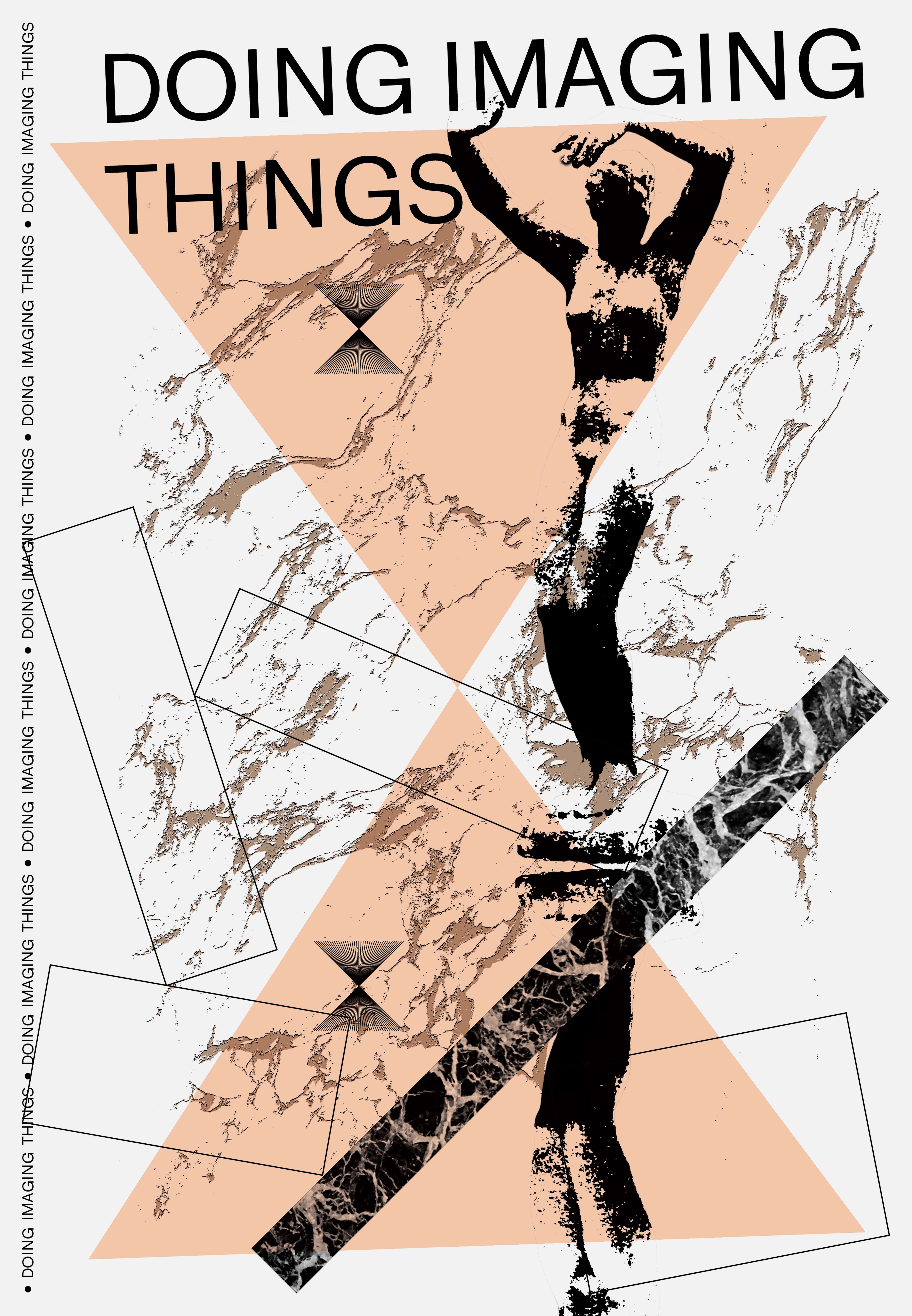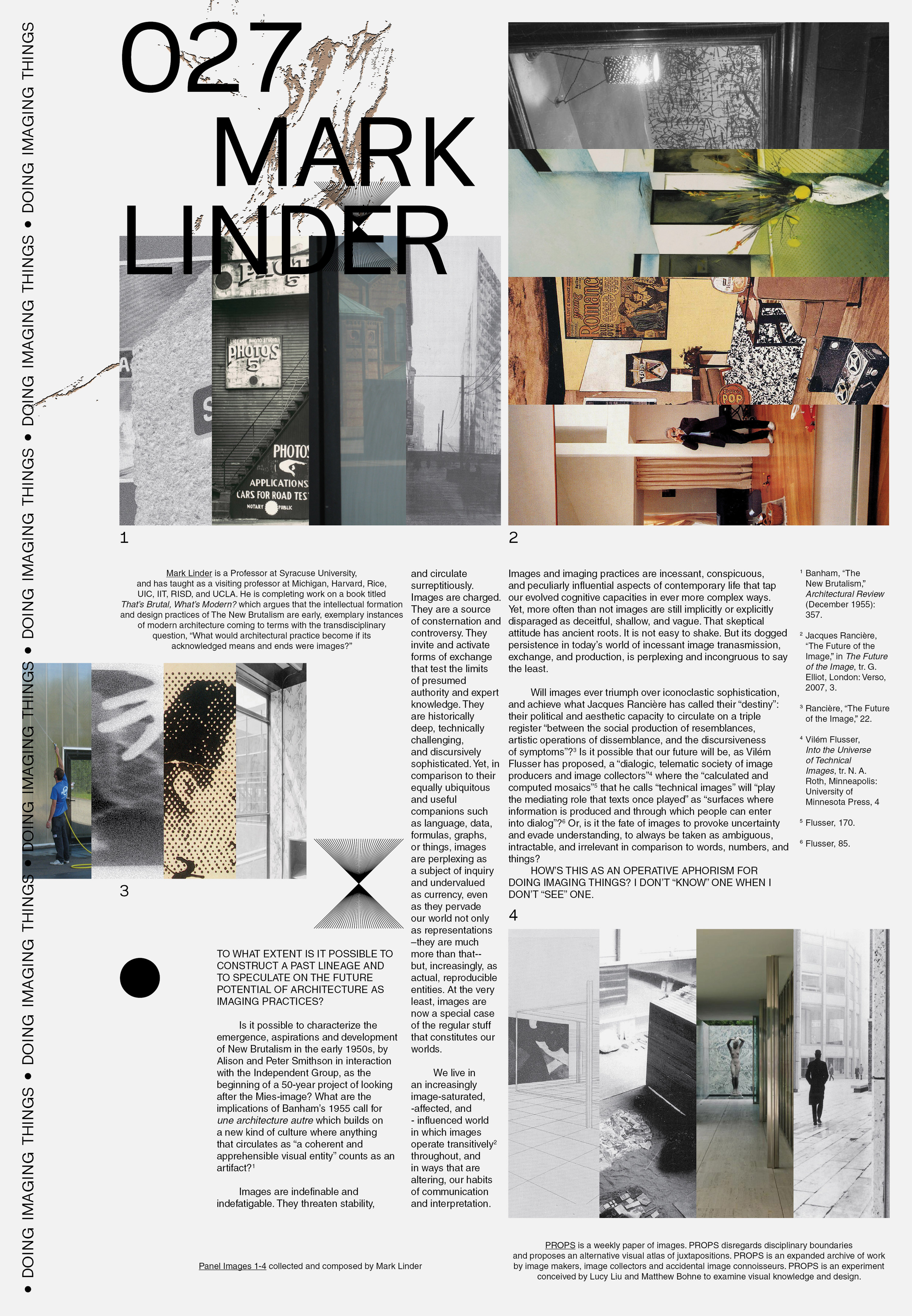

27 DOING IMAGING THINGS
MARK LINDER︎︎︎
What might architectural practice become if its primary means and ends were imaging? To what extent is it possible to construct a past lineage and to speculate on the future potential of architecture as imaging practices?
Is it possible to characterize the emergence, aspirations and development of New Brutalism in the early 1950s, by Alison and Peter Smithson in interaction with the Independent Group, as the beginning of a 50-year project of looking after the Mies-image? What are the implications of Banham’s 1955 call for une architecture autre that builds on a new kind of culture where anything that circulates as “a coherent and apprehensible visual entity” counts as an artifact? 1
Images are indefinable and indefatigable. They threaten stability, and circulate surreptitiously. Images are charged. They are a source of consternation and controversy. They invite and activate forms of exchange that test the limits of presumed authority and expert knowledge. They are historically deep, technically challenging, and discursively sophisticated. Yet, in comparison to their equally ubiquitous and useful companions such as language, data, formulas, graphs, or things, images are perplexing as a subject of inquiry and undervalued as currency, even as they pervade our world not only as representations –they are much more than that– but, increasingly, as actual, reproducible entities. At the very least, images are now a special case of the regular stuff that constitutes our worlds.
We live in an increasingly image-saturated, -affected, and –influenced world in which images operate transitively throughout, and in ways that are altering our habits of communication and interpretation.2 Images and imaging practices are incessant, conspicuous, and peculiarly influential aspects of contemporary life that tap our evolved cognitive capacities in ever more complex ways. Yet, more often than not images are still implicitly or explicitly disparaged as deceitful, shallow, and vague. That skeptical attitude has ancient roots. It is not easy to shake. But its dogged persistence in today’s world of incessant image transmission, exchange, and production, is perplexing and incongruous to say the least.
Will images ever triumph over iconoclastic sophistication, and achieve what Jacques Rancière has called their “destiny”: their political and aesthetic capacity to circulate on a triple register “between the social production of resemblances, artistic operations of dissemblance, and the discursiveness of symptoms?” 3 Is it possible that our future will be, as Vilém Flusser has proposed, a “dialogic, telematic society of image producers and image collectors” 4 where the “calculated and computed mosaics” 5 that he calls “technical images” will “play the mediating role that texts once played” as “surfaces where information is produced and through which people can enter into dialog”? 6 Or, is it the fate of images to provoke uncertainty and evade understanding, to always be taken as ambiguous, intractable, and irrelevant in comparison to words, numbers, and things?
How’s this as an operative aphorism for doing imaging things? I don’t “know” one when I don’t “see” one.
Notes:
1 Banham, “The New Brutalism,” Architectural Review (December 1955): 357.
2 Jacques Rancière, “The Future of the Image,” in The Future of the Image, tr. G. Elliot, London: Verso, 2007, 3.
3 Rancière, “The Future of the Image,” 22.
4 Vilém Flusser, Into the Universe of Technical Images, tr. N. A. Roth, Minneapolis: University of Minnesota Press, 4.
5 Flusser, 170.
6 Flusser, 85.
MARK LINDER︎︎︎ is a professor at Syracuse University, and has taught as a visiting professor at Michigan, Harvard, Rice, UIC, IIT, RISD, and UCLA. He is completing work on a book titled That’s Brutal, What’s Modern? which argues that the intellectual formation and design practices of The New Brutalism are early, exemplary instances of modern architecture coming to terms with the transdisciplinary question, “What would architectural practice become if its acknowledged means and ends were images?”
What might architectural practice become if its primary means and ends were imaging? To what extent is it possible to construct a past lineage and to speculate on the future potential of architecture as imaging practices?
Is it possible to characterize the emergence, aspirations and development of New Brutalism in the early 1950s, by Alison and Peter Smithson in interaction with the Independent Group, as the beginning of a 50-year project of looking after the Mies-image? What are the implications of Banham’s 1955 call for une architecture autre that builds on a new kind of culture where anything that circulates as “a coherent and apprehensible visual entity” counts as an artifact? 1
Images are indefinable and indefatigable. They threaten stability, and circulate surreptitiously. Images are charged. They are a source of consternation and controversy. They invite and activate forms of exchange that test the limits of presumed authority and expert knowledge. They are historically deep, technically challenging, and discursively sophisticated. Yet, in comparison to their equally ubiquitous and useful companions such as language, data, formulas, graphs, or things, images are perplexing as a subject of inquiry and undervalued as currency, even as they pervade our world not only as representations –they are much more than that– but, increasingly, as actual, reproducible entities. At the very least, images are now a special case of the regular stuff that constitutes our worlds.
We live in an increasingly image-saturated, -affected, and –influenced world in which images operate transitively throughout, and in ways that are altering our habits of communication and interpretation.2 Images and imaging practices are incessant, conspicuous, and peculiarly influential aspects of contemporary life that tap our evolved cognitive capacities in ever more complex ways. Yet, more often than not images are still implicitly or explicitly disparaged as deceitful, shallow, and vague. That skeptical attitude has ancient roots. It is not easy to shake. But its dogged persistence in today’s world of incessant image transmission, exchange, and production, is perplexing and incongruous to say the least.
Will images ever triumph over iconoclastic sophistication, and achieve what Jacques Rancière has called their “destiny”: their political and aesthetic capacity to circulate on a triple register “between the social production of resemblances, artistic operations of dissemblance, and the discursiveness of symptoms?” 3 Is it possible that our future will be, as Vilém Flusser has proposed, a “dialogic, telematic society of image producers and image collectors” 4 where the “calculated and computed mosaics” 5 that he calls “technical images” will “play the mediating role that texts once played” as “surfaces where information is produced and through which people can enter into dialog”? 6 Or, is it the fate of images to provoke uncertainty and evade understanding, to always be taken as ambiguous, intractable, and irrelevant in comparison to words, numbers, and things?
How’s this as an operative aphorism for doing imaging things? I don’t “know” one when I don’t “see” one.
Notes:
1 Banham, “The New Brutalism,” Architectural Review (December 1955): 357.
2 Jacques Rancière, “The Future of the Image,” in The Future of the Image, tr. G. Elliot, London: Verso, 2007, 3.
3 Rancière, “The Future of the Image,” 22.
4 Vilém Flusser, Into the Universe of Technical Images, tr. N. A. Roth, Minneapolis: University of Minnesota Press, 4.
5 Flusser, 170.
6 Flusser, 85.
MARK LINDER︎︎︎ is a professor at Syracuse University, and has taught as a visiting professor at Michigan, Harvard, Rice, UIC, IIT, RISD, and UCLA. He is completing work on a book titled That’s Brutal, What’s Modern? which argues that the intellectual formation and design practices of The New Brutalism are early, exemplary instances of modern architecture coming to terms with the transdisciplinary question, “What would architectural practice become if its acknowledged means and ends were images?”